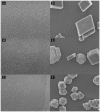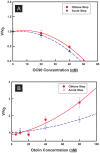In vitro calcite crystal morphology is modulated by otoconial proteins otolin-1 and otoconin-90
- PMID: 24748133
- PMCID: PMC3991680
- DOI: 10.1371/journal.pone.0095333
In vitro calcite crystal morphology is modulated by otoconial proteins otolin-1 and otoconin-90
Abstract
Otoconia are formed embryonically and are instrumental in detecting linear acceleration and gravity. Degeneration and fragmentation of otoconia in elderly patients leads to imbalance resulting in higher frequency of falls that are positively correlated with the incidence of bone fractures and death. In this work we investigate the roles otoconial proteins Otolin-1 and Otoconin 90 (OC90) perform in the formation of otoconia. We demonstrate by rotary shadowing and atomic force microscopy (AFM) experiments that Otolin-1 forms homomeric protein complexes and self-assembled networks supporting the hypothesis that Otolin-1 serves as a scaffold protein of otoconia. Our calcium carbonate crystal growth data demonstrate that Otolin-1 and OC90 modulate in vitro calcite crystal morphology but neither protein is sufficient to produce the shape of otoconia. Coadministration of these proteins produces synergistic effects on crystal morphology that contribute to morphology resembling otoconia.
Conflict of interest statement
Figures






Similar articles
-
Gene targeting reveals the role of Oc90 as the essential organizer of the otoconial organic matrix.Dev Biol. 2007 Apr 15;304(2):508-24. doi: 10.1016/j.ydbio.2007.01.013. Epub 2007 Jan 12. Dev Biol. 2007. PMID: 17300776 Free PMC article.
-
Mammalian Otolin: a multimeric glycoprotein specific to the inner ear that interacts with otoconial matrix protein Otoconin-90 and Cerebellin-1.PLoS One. 2010 Sep 15;5(9):e12765. doi: 10.1371/journal.pone.0012765. PLoS One. 2010. PMID: 20856818 Free PMC article.
-
Matrix recruitment and calcium sequestration for spatial specific otoconia development.PLoS One. 2011;6(5):e20498. doi: 10.1371/journal.pone.0020498. Epub 2011 May 31. PLoS One. 2011. PMID: 21655225 Free PMC article.
-
Development and maintenance of otoconia: biochemical considerations.Ann N Y Acad Sci. 2001 Oct;942:162-78. doi: 10.1111/j.1749-6632.2001.tb03743.x. Ann N Y Acad Sci. 2001. PMID: 11710459 Review.
-
Otoconia in health and disease. A review.Ann Otol Rhinol Laryngol Suppl. 1984 Jul-Aug;112:17-24. doi: 10.1177/00034894840930s404. Ann Otol Rhinol Laryngol Suppl. 1984. PMID: 6431876 Review.
Cited by
-
Otoconia and otolithic membrane fragments within the posterior semicircular canal in benign paroxysmal positional vertigo.Laryngoscope. 2017 Mar;127(3):709-714. doi: 10.1002/lary.26115. Epub 2016 Oct 11. Laryngoscope. 2017. PMID: 27726156 Free PMC article.
-
Effect of Otoconial Proteins Fetuin A, Osteopontin, and Otoconin 90 on the Nucleation and Growth of Calcite.Cryst Growth Des. 2015 Jan 7;15(1):129-136. doi: 10.1021/cg501001r. Epub 2014 Oct 30. Cryst Growth Des. 2015. PMID: 25709560 Free PMC article.
-
High Serum Levels of Otolin-1 in Patients With Benign Paroxysmal Positional Vertigo Predict Recurrence.Front Neurol. 2022 Mar 14;13:841677. doi: 10.3389/fneur.2022.841677. eCollection 2022. Front Neurol. 2022. PMID: 35359660 Free PMC article.
-
Advances in otolith-related protein research.Front Neurosci. 2022 Jul 26;16:956200. doi: 10.3389/fnins.2022.956200. eCollection 2022. Front Neurosci. 2022. PMID: 35958995 Free PMC article. Review.
-
Principles of calcite dissolution in human and artificial otoconia.PLoS One. 2014 Jul 21;9(7):e102516. doi: 10.1371/journal.pone.0102516. eCollection 2014. PLoS One. 2014. PMID: 25048115 Free PMC article.
References
-
- Weiner S, Wagner HD (1998) THE MATERIAL BONE: Structure-Mechanical Function Relations. Annual Review of Materials Science 28: 271–298.
-
- Ross M, Peacor D, Johnsson L, Allard L (1976) Observations on normal and degenerating human otoconia. Ann Otol Rhinol Laryngol 85: 310–326. - PubMed
-
- Lim DJ (1984) Otoconia in health and disease. A review. Ann Otol Rhinol Laryngol Suppl 112: 17–24. - PubMed
-
- Anniko M, Ylikoski J, Wroblewski R (1984) Microprobe analysis of human otoconia. Acta Otolaryngol 97: 283–289. - PubMed
-
- Agrawal Y, Carey JP, Della Santina CC, Schubert MC, Minor LB (2009) Disorders of balance and vestibular function in US adults: data from the National Health and Nutrition Examination Survey, 2001–2004. Arch Intern Med 169: 938–944. - PubMed
Publication types
MeSH terms
Substances
Grants and funding
LinkOut - more resources
Full Text Sources
Other Literature Sources
Molecular Biology Databases
Miscellaneous

